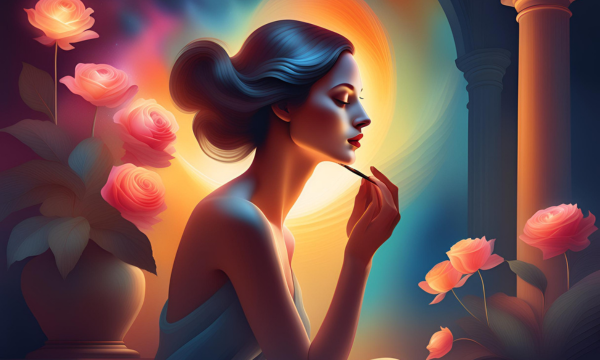Beauty & Art: A Love Story That’s More Complicated Than Your Last Relationship (2025 Edition)
Picture this: As you view NeuraGram (future social media) content you find side-by-side an old Renaissance artwork followed by an AI-produced picture of a space cat. Both stop your thumb in its tracks. Both make you feel something. But why? We need to explore why beauty and art created the biggest romance ever seen between two things.
The Classic Tale: When Beauty Met Art
When you first saw something that stopped your heart did you feel that initial attraction? You likely came across art which moved you through Van Gogh’s Starry Night designed for your grade school textbook or a renowned street artwork that showed up suddenly near your residence. That gut-punch reaction? This is beauty doing what comes to it naturally. From our earliest cave paintings human beings have worked to express and communicate beauty through art. Despite popular belief artwork produces something as beautiful as a whimsical snowflake. During ancient Greece people thought great art should display ideal symmetry and balance similar to early photo filter technologies. They thought that true beauty followed set mathematical standards. When discussing aesthetic evolution Plato would struggle to grasp how a banana taped to a wall could fetch $120,000 as art.
However we continue experiencing difficulties between beauty and art in modern times. Our modern technological tools have transformed beauty standards into personal opinions for individuals. Painting teams craft art that defies traditional beauty standards because powerful art makes us feel uneasy. Digital artists now use computers to craft flawless portraits of nonexistent individuals while other makers produce plain or bizarre work that seems truer than exquisite creation.
The Modern Romance: Beauty in the Age of Digital Art
Get your virtual reality headsets ready because beauty in 2025 seems undefined and it will surprise you. Art technology and creative freedom now produce beautiful outcomes from sources that never produced beauty before. Some glitch mages appear so unnatural that the computer appeared to malfunction. Beautiful. What if something exists between actual environments and our sleeping moments? Stunning. People now struggle to tell which artworks come from humans and which ones machines produce but these confusing creations challenge philosophical understanding.
Modern art now consists of more than pleasing images – we see beauty through how art innovates our responses and affects society. The new pattern of using living organisms with artists leads to art installations that morph over time. The process of seeing a sculpture transform before your eyes becomes aesthetically captivating even when it does not align with classic beauty standards. Using augmented reality artists now design our urban spaces to look like art displays. Visual simulations of massive flowing water successfully display downward motion on a building’s exterior. Today’s beauty accepts computer technology alongside its traditional canvas-based existence.
The Dark Horse: When “Ugly” Becomes Beautiful
The next part unveles surprising discoveries about art. The changes happening to beauty standards in art reached their peak in 2025. Artists today embrace crassness, distortion and pixelation as primary styles in their work. In current art trends artists reject a flawless creation style to celebrate the natural beauty in flaws. Social media and digital platforms have strongly boosted this art movement that artists have practiced since expressionism began.
Artists now make art that startles viewers but eventually traps them with sincere emotional content. AI-produced portraits that deviate from traditional standards draw viewers because their flaws create visual intrigue better than polished digital images do. Some digital artists now reject traditional design standards and produce artwork that connects with audiences better than intended designs would. Observing someone reject their normal behavior feels weird until they produce life-changing results that seem real.
The Science Behind the Magic: Beauty and the Brain
Science geeks will enjoy learning about this subject. In 2025 top scientists study what our brains do when we view aesthetic art and discover humans possess natural chemical reactions to beauty. When we discover beautiful art our brain releases pleasure-stimulating neurotransmitters alongside dopamine and serotonin chemicals. But here’s the kicker: these reactions aren’t universal. Neural stimulation patterns vary widely between different people depending on what they see.
Our brains develop new ways to understand and grasp different forms of artistic beauty each day. Peer-reviewed research finds that digital art and AI-made creations reshape our brain’s response to attractiveness each time we see them. Our brains now prefer beauty formats that would surprise our older generations. Our brains receive artistic appreciation updates that show biology modifies what counts as beautiful. Research proves that viewing digital art helps people spot beauty in less obvious forms and more intricate arrangements.
The Future: Beauty 2.0 (or Maybe 3.0?)
The future direction between beauty and art remains unknown. Haptic technology brings beauty to life by combining visual experience with physical touch and more. You could tour a digital gallery whose art pieces react to your feelings while music you compose generates visual art elements that shift according to brainwave patterns. South of normal sci-fi dreams these new artistic ways let us explore beauty’s undiscovered realm.
Today artists are expanding the definition of beauty to include everyone. Artists from diverse backgrounds use cultural insights to redefine beauty while creating different ways to view art that strengthens our artistic community today. Art’s future won’t require one standard of beauty because individuals can keep discovering new ways to perceive and make beauty.
The Plot Twist: When Beauty Isn’t the Point
Here’s a thought that might make your brain do a backflip: Powerful artwork can create a different effect without having to look beautiful. Even the most important modern artwork exists to challenge our taste for artistic beauty. They look bad on purpose to disturb and confuse viewers. These works prove that art exists beyond its need to create pleasing visual experiences or emotional comfort. Art functions to disrupt our peace and motivate us to consider new ideas.
Although it appears contradictory our minds often spot depth and allure in works that reject pleasant aesthetics. When you notice unfamiliar sounds that make you uncomfortable they become interesting because you understand their structured meaning. At this point the connection between beauty and art becomes hard to understand because we see value in things that hate beauty.
The Bottom Line (With a Cherry on Top)
How does beauty link to art during 2025? Everything and nothing. Beauty and art exist as both intense affection and challenging camaraderie alongside fierce competition. Beauty in art transformed from basic visual enjoyment into examining how technology affects our cultural view of the world. Our ongoing search to define beauty includes artists who work with traditional tools and digital methods as well as anyone who experiences visual content through their holographic display screens.
Want to dive deeper into this beautiful mess? You can find my weekly art reflections on the MetaVerse Art Channel by entering into the virtual space to learn about these concepts. You can take your inspiration from this post and either make visually stunning or intentionally bad art according to your creative impulses. By 2025 every person will create art while deciding what beauty means to them.
Remember: Beauty may be in the eye of the beholder, but art is what makes those eyes see things they never imagined possible.
[End note: Stay creative, stay curious, and never stop questioning what makes something beautiful. Your next favorite artwork might just be something you currently think is ugly – and isn’t that beautiful?]

